Data center
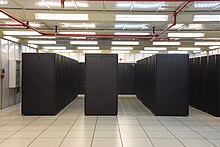
Adata center(American English)[1]ordata centre(Commonwealth English)[2][note 1]is abuilding,a dedicated space within a building, or a group of buildings[3]used to housecomputer systemsand associated components, such astelecommunicationsandstorage systems.[4][5]
SinceIT operationsare crucial forbusiness continuity,it generally includesredundantor backup components and infrastructure forpower supply,data communication connections, environmental controls (e.g.,air conditioning,fire suppression), and various security devices. A large data center is an industrial-scale operation using as much electricity as a small town.[6]Estimated global data center electricity consumption in 2022 was 240–340 TWh,or roughly 1–1.3% of global electricity demand. This excludes energy used for cryptocurrency mining, which was estimated to be around 110 TWh in 2022, or another 0.4% of global electricity demand.[7]TheIEAprojects that data center electric use could double between 2022 and 2026.[8]High demand for electricity from data centers, including bycryptominingandartificial intelligence,has also increased strain on local electric grids and increased electricity prices in some markets.
Data centers can vary widely in terms of size, power requirements, redundancy, and overall structure. Four common categories used to segment types of data centers are onsite data centers, colocation facilities, hyperscale data centers, and edge data centers.[9]
History
[edit]
Data centers have their roots in the huge computer rooms of the 1940s, typified byENIAC,one of the earliest examples of a data center.[10][note 2]Early computer systems, complex to operate and maintain, required a special environment in which to operate. Many cables were necessary to connect all the components, and methods to accommodate and organize these were devised such as standardracksto mount equipment,raised floors,andcable trays(installed overhead or under the elevated floor). A singlemainframerequired a great deal of power and had to be cooled to avoid overheating. Security became important – computers were expensive, and were often used formilitarypurposes.[10][note 3]Basic design guidelines for controlling access to the computer room were therefore devised.
During the boom of the microcomputer industry, and especially during the 1980s, users started to deploy computers everywhere, in many cases with little or no care about operating requirements. However, asinformation technology (IT) operationsstarted to grow in complexity, organizations grew aware of the need to control IT resources. The availability of inexpensivenetworkingequipment, coupled with new standards for the networkstructured cabling,made it possible to use a hierarchical design that put the servers in a specific room inside the company. The use of the termdata center,as applied to specially designed computer rooms, started to gain popular recognition about this time.[10][note 4]
A boom of data centers came during thedot-com bubbleof 1997–2000.[11][note 5]Companiesneeded fastInternetconnectivity and non-stop operation to deploy systems and to establish a presence on the Internet. Installing such equipment was not viable for many smaller companies. Many companies started building very large facilities, calledinternet data centers(IDCs),[12]which provide enhanced capabilities, such as crossover backup: "If a Bell Atlantic line is cut, we can transfer them to... to minimize the time of outage."[12]
The termcloud data centers(CDCs) has been used.[13]Data centers typically cost a lot to build and maintain.[11]Increasingly, the division of these terms has almost disappeared and they are being integrated into the termdata center.[14]
The global data center market saw steady growth in the 2010s, with a notable acceleration in the latter half of the decade. According toGartner,worldwide data center infrastructure spending reached $200 billion in 2021, representing a 6% increase from 2020 despite the economic challenges posed by theCOVID-19 pandemic.[15]
The latter part of the 2010s and early 2020s saw a significant shift towardsAIandmachine learningapplications, generating a global boom for more powerful and efficient data center infrastructure. As of March 2021, global data creation was projected to grow to more than 180 zettabytes by 2025, up from 64.2 zettabytes in 2020.[16]
Amidst the recent boom of development, the United States has established a position as the leader in data center infrastructure, hosting 5,381 data centers as of March 2024, the highest number of any country worldwide.[17]According to global consultancy McKinsey & Co., U.S. market demand is expected to double to 35 gigawatts (GW) by 2030, up from 17 GW in 2022.[18]As of 2023, the U.S. accounts for roughly 40 percent of the global market.[19]
A study published by theElectric Power Research Institute (EPRI)in May 2024 estimates U.S. data center power consumption could range from 4.6% to 9.1% of the country’s generation by 2030.[20]As of 2023, about 80% of U.S. data center load was concentrated in 15 states, led by Virginia and Texas.[21]
Requirements for modern data centers
[edit]
Modernization and data center transformation enhances performance andenergy efficiency.[22]
Information securityis also a concern, and for this reason, a data center has to offer a secure environment that minimizes the chances of a security breach. A data center must, therefore, keep high standards for assuring the integrity and functionality of its hosted computer environment.
Industry research companyInternational Data Corporation(IDC) puts the average age of a data center at nine years old.[22]Gartner,another research company, says data centers older than seven years are obsolete.[23]The growth in data (163 zettabytes by 2025[24]) is one factor driving the need for data centers to modernize.
Focus onmodernizationis not new: concern about obsolete equipment was decried in 2007,[25]and in 2011Uptime Institutewas concerned about the age of the equipment therein.[note 6]By 2018 concern had shifted once again, this time to the age of the staff: "data center staff are aging faster than the equipment."[26]
Meeting standards for data centers
[edit]TheTelecommunications Industry Association's Telecommunications Infrastructure Standard for Data Centers[27]specifies the minimum requirements for telecommunications infrastructure of data centers and computer rooms including single tenant enterprise data centers and multi-tenant Internet hosting data centers. The topology proposed in this document is intended to be applicable to any size data center.[28]
Telcordia GR-3160,NEBS Requirements for Telecommunications Data Center Equipment and Spaces,[29]provides guidelines for data center spaces within telecommunications networks, and environmental requirements for the equipment intended for installation in those spaces. These criteria were developed jointly by Telcordia and industry representatives. They may be applied to data center spaces housing data processing or Information Technology (IT) equipment. The equipment may be used to:
- Operate and manage a carrier's telecommunication network
- Provide data center based applications directly to the carrier's customers
- Provide hosted applications for a third party to provide services to their customers
- Provide a combination of these and similar data center applications
Data center transformation
[edit]Data center transformation takes a step-by-step approach through integrated projects carried out over time. This differs from a traditional method of data center upgrades that takes a serial and siloed approach.[30]The typical projects within a data center transformation initiative include standardization/consolidation,virtualization,automationand security.
- Standardization/consolidation: Reducing the number of data centers[31][32]and avoidingserver sprawl[33](both physical and virtual)[34]often includes replacing aging data center equipment,[35]and is aided by standardization.[36]
- Virtualization: Lowers capital and operational expenses,[37]reduces energy consumption.[38]Virtualized desktops can be hosted in data centers and rented out on a subscription basis.[39]Investment bank Lazard Capital Markets estimated in 2008 that 48 percent of enterprise operations will be virtualized by 2012. Gartner views virtualization as a catalyst for modernization.[40]
- Automating: Automating tasks such asprovisioning,configuration,patching,release management, and compliance is needed, not just when facing fewer skilled IT workers.[36]
- Securing: Protection of virtual systems is integrated with the existing security of physical infrastructures.[41]
Raised floor
[edit]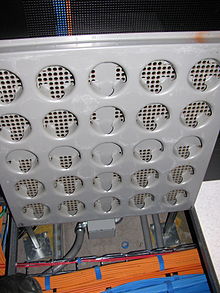
A raised floor standards guide named GR-2930 was developed byTelcordia Technologies,a subsidiary ofEricsson.[42]
Although the firstraised floorcomputer room was made byIBMin 1956,[43]and they've "been around since the 1960s",[44]it was the 1970s that made it more common for computer centers to thereby allow cool air to circulate more efficiently.[45][46]
The first purpose of the raised floor was to allow access for wiring.[43]
Lights out
[edit]Thelights-out[47]data center, also known as a darkened or a dark data center, is a data center that, ideally, has all but eliminated the need for direct access by personnel, except under extraordinary circumstances. Because of the lack of need for staff to enter the data center, it can be operated without lighting. All of the devices are accessed and managed by remote systems, with automation programs used to perform unattended operations. In addition to the energy savings, reduction in staffing costs and the ability to locate the site further from population centers, implementing a lights-out data center reduces the threat of malicious attacks upon the infrastructure.[48][49]
Noise levels
[edit]Generally speaking, local authorities prefer noise levels at data centers to be "10 dB below the existing night-time background noise level at the nearest residence."[50]
OSHA regulations require monitoring of noise levels inside data centers if noise exceeds 85 decibels.[51]The average noise level in server areas of a data center may reach as high as 92-96 dB(A).[52]
Residents living near data centers have described the sound as "a high-pitched whirring noise 24/7", saying “It’s like being on atarmacwith an airplane engine running constantly... Except that the airplane keeps idling and never leaves.”[53][54][55][56]
External sources of noise include HVAC equipment and energy generators.[57][58]
Data center design
[edit]The field ofdata center designhas been growing for decades in various directions, including new construction big and small along with the creative re-use of existing facilities, like abandoned retail space, old salt mines and war-era bunkers.
- a 65-story data center has already been proposed[59]
- the number of data centers as of 2016 had grown beyond 3 million USA-wide, and more than triple that number worldwide[11]
Local building codes may govern the minimum ceiling heights and other parameters. Some of the considerations in the design of data centers are:
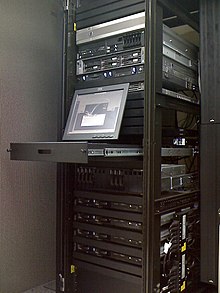
- Size - one room of a building, one or more floors, or an entire building,
- Capacity - can hold up to or past 1,000 servers[60]
- Other considerations - Space, power, cooling, and costs in the data center.[61]
- Mechanical engineering infrastructure - heating, ventilation and air conditioning (HVAC); humidification and dehumidification equipment; pressurization.[62]
- Electrical engineering infrastructure design - utility service planning; distribution, switching and bypass from power sources;uninterruptible power source(UPS) systems; and more.[62][63]

Design criteria and trade-offs
[edit]- Availability expectations:The costs of avoiding downtime should not exceed the cost of the downtime itself[64]
- Site selection:Location factors include proximity to power grids, telecommunications infrastructure, networking services, transportation lines and emergency services. Other considerations should include flight paths, neighboring power drains, geological risks, and climate (associated with cooling costs).[65]
- Often, power availability is the hardest to change.
High availability
[edit]Various metrics exist for measuring the data-availability that results from data-center availability beyond 95% uptime, with the top of the scale counting how manyninescan be placed after99%.[66]
Modularity and flexibility
[edit]Modularity and flexibility are key elements in allowing for a data center to grow and change over time. Data center modules are pre-engineered, standardized building blocks that can be easily configured and moved as needed.[67]
A modular data center may consist of data center equipment contained within shipping containers or similar portable containers.[68]Components of the data center can be prefabricated and standardized which facilitates moving if needed.[69]
Environmental control
[edit]Temperatureand humidity are controlled via:
- Air conditioning
- indirect cooling, such as using outside air,[70][71][note 7]Indirect Evaporative Cooling (IDEC) units, and also using sea water.
It is important that computers do not get humid or overheat, as high humidity can lead to dust clogging the fans, which leads to overheat, or can cause components to malfunction, ruining the board and running a fire hazard. Overheat can cause components, usually the silicon or copper of the wires or circuits to melt, causing connections to loosen, causing fire hazards.
Electrical power
[edit]
Backup power consists of one or moreuninterruptible power supplies,battery banks, and/ordiesel/gas turbinegenerators.[72]
To preventsingle points of failure,all elements of the electrical systems, including backup systems, are typically givenredundant copies,and critical servers are connected to both theA-sideandB-sidepower feeds. This arrangement is often made to achieveN+1 redundancyin the systems.Static transfer switchesare sometimes used to ensure instantaneous switchover from one supply to the other in the event of a power failure.
Low-voltage cable routing
[edit]Options include:
- Data cabling can be routed through overheadcable trays[73]
- Raised floor cabling, both for security reasons and to avoid the extra cost of cooling systems over the racks.
- Smaller/less expensive data centers may use anti-static tiles instead for a flooring surface.
Air flow
[edit]Air flowmanagement addresses the need to improve data centercomputer coolingefficiency by preventing the recirculation of hot air exhausted from IT equipment and reducing bypass airflow. There are several methods of separating hot and cold airstreams, such as hot/cold aisle containment and in-row cooling units.[74]
Aisle containment
[edit]Cold aisle containment is done by exposing the rear of equipment racks, while the fronts of the servers are enclosed with doors and covers. This is similar to how large-scale food companies refrigerate and store their products.
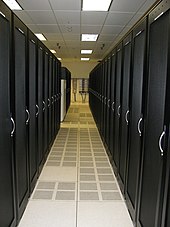
Computer cabinets/Server farmsare often organized for containment of hot/cold aisles. Proper air duct placement prevents the cold and hot air from mixing. Rows of cabinets are paired to face each other so that the cool and hot air intakes and exhausts don't mix air, which would severely reduce cooling efficiency.
Alternatively, a range of underfloor panels can create efficient cold air pathways directed to the raised-floor vented tiles. Either the cold aisle or the hot aisle can be contained.[75]
Another option is fitting cabinets with vertical exhaust ductchimneys.[76]Hot exhaust pipes/vents/ducts can direct the air into aPlenum spaceabove aDropped ceilingand back to the cooling units or to outside vents. With this configuration, traditional hot/cold aisle configuration is not a requirement.[77]
Fire protection
[edit]
Data centers featurefire protectionsystems, includingpassiveandActive Designelements, as well as implementation offire preventionprograms in operations.Smoke detectorsare usually installed to provide early warning of a fire at its incipient stage.
Although the main room usually does not allowWet Pipe-based Systemsdue to the fragile nature ofCircuit-boards,there still exist systems that can be used in the rest of the facility or in cold/hot aisle air circulation systems that areclosed systems,such as:[78]
- Sprinkler systems
- Misting, using high pressure to create extremely small water droplets, which can be used in sensitive rooms due to the nature of the droplets.
However, there also exist other means to put out fires, especially inSensitive areas,usually usingGaseous fire suppression,of whichHalon gaswas the most popular, until the negative effects of producing and using it were discovered.[1]
Security
[edit]Physical access is usually restricted. Layered security often starts with fencing,bollardsandmantraps.[79]Video camerasurveillance and permanentsecurity guardsare almost always present if the data center is large or contains sensitive information. Fingerprint recognition mantraps are starting to be commonplace.
Logging access is required by some data protection regulations; some organizations tightly link this to access control systems. Multiple log entries can occur at the main entrance, entrances to internal rooms, and at equipment cabinets. Access control at cabinets can be integrated with intelligentpower distribution units,so that locks are networked through the same appliance.[80]
Energy use
[edit]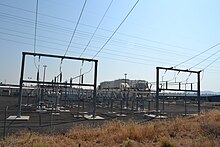
Energy use is a central issue for data centers. Power draw ranges from a few kW for a rack of servers in a closet to several tens of MW for large facilities. Some facilities have power densities more than 100 times that of a typical office building.[81]For higher power density facilities, electricity costs are a dominantoperating expenseand account for over 10% of thetotal cost of ownership(TCO) of a data center.[82]
Greenhouse gas emissions
[edit]In 2020, data centers (excluding cryptocurrency mining) and data transmission each used about 1% of world electricity.[83]Although some of this electricity was low carbon, theIEAcalled for more "government and industry efforts on energy efficiency, renewables procurement and RD&D",[83]as some data centers still use electricity generated by fossil fuels.[84]They also said that lifecycle emissions should be considered, that is includingembodiedemissions, such as in buildings.[83]Data centers are estimated to have been responsible for 0.5% of US greenhouse gas emissions in 2018.[85]Some Chinese companies, such asTencent,have pledged to be carbon neutral by 2030, while others such asAlibabahave been criticized byGreenpeacefor not committing to become carbon neutral.[86]Google and Microsoft now each consume more power than some fairly big countries, surpassing the consumption of more than 100 countries.[87]
Energy efficiency and overhead
[edit]The most commonly used energy efficiency metric for data centers ispower usage effectiveness(PUE), calculated as the ratio of total power entering the data center divided by the power used by IT equipment.
PUE measures the percentage of power used by overhead devices (cooling, lighting, etc.). The average USA data center has a PUE of 2.0,[88]meaning two watts of total power (overhead + IT equipment) for every watt delivered to IT equipment. State-of-the-art data centers are estimated to have a PUE of roughly 1.2.[89]Googlepublishes quarterly efficiency metrics from its data centers in operation.[90]PUEs of as low as 1.01 have been achieved with two phase immersion cooling.[91]
TheU.S. Environmental Protection Agencyhas anEnergy Starrating for standalone or large data centers. To qualify for the ecolabel, a data center must be within the top quartile in energy efficiency of all reported facilities.[92]The Energy Efficiency Improvement Act of 2015 (United States) requires federal facilities — including data centers — to operate more efficiently. California'sTitle 24(2014) of the California Code of Regulations mandates that every newly constructed data center must have some form of airflow containment in place to optimize energy efficiency.
The European Union also has a similar initiative: EU Code of Conduct for Data Centres.[93]
Energy use analysis and projects
[edit]The focus of measuring and analyzing energy use goes beyond what is used by IT equipment; facility support hardware such as chillers and fans also use energy.[94]
In 2011, server racks in data centers were designed for more than 25 kW and the typical server was estimated to waste about 30% of the electricity it consumed. The energy demand for information storage systems is also rising. A high-availability data center is estimated to have a 1 megawatt (MW) demand and consume $20,000,000 in electricity over itslifetime,with cooling representing 35% to 45% of the data center'stotal cost of ownership.Calculations show that in two years, the cost of powering and cooling a server could be equal to the cost of purchasing the server hardware.[95]Research in 2018 has shown that a substantial amount of energy could still be conserved by optimizing IT refresh rates and increasing server utilization.[96]
In 2011,Facebook,Rackspaceand others founded theOpen Compute Project(OCP) to develop and publish open standards for greener data center computing technologies. As part of the project, Facebook published the designs of its server, which it had built for its first dedicated data center in Prineville. Making servers taller left space for more effectiveheat sinksand enabled the use of fans that moved more air with less energy. By not buyingcommercial off-the-shelfservers, energy consumption due to unnecessary expansion slots on themotherboardand unneeded components, such as agraphics card,was also saved.[97]In 2016, Google joined the project and published the designs of its 48V DC shallow data center rack. This design had long been part ofGoogle data centers.By eliminating the multipletransformersusually deployed in data centers, Google had achieved a 30% increase in energy efficiency.[98]In 2017, sales for data center hardware built to OCP designs topped $1.2 billion and are expected to reach $6 billion by 2021.[97]
Power and cooling analysis
[edit]
Power is the largest recurring cost to the user of a data center.[99]Cooling it at or below 70 °F (21 °C) wastes money and energy.[99]Furthermore, overcooling equipment in environments with a high relative humidity can expose equipment to a high amount of moisture that facilitates the growth of salt deposits on conductive filaments in the circuitry.[100]
Apower and cooling analysis,also referred to as a thermal assessment, measures the relative temperatures in specific areas as well as the capacity of the cooling systems to handle specific ambient temperatures.[101]A power and cooling analysis can help to identify hot spots, over-cooled areas that can handle greater power use density, the breakpoint of equipment loading, the effectiveness of a raised-floor strategy, and optimal equipment positioning (such as AC units) to balance temperatures across the data center. Power cooling density is a measure of how much square footage the center can cool at maximum capacity.[102]The cooling of data centers is the second largest power consumer after servers. The cooling energy varies from 10% of the total energy consumption in the most efficient data centers and goes up to 45% in standard air-cooled data centers.
Energy efficiency analysis
[edit]An energy efficiency analysis measures the energy use of data center IT and facilities equipment. A typical energy efficiency analysis measures factors such as a data center's Power Use Effectiveness (PUE) against industry standards, identifies mechanical and electrical sources of inefficiency, and identifies air-management metrics.[103]However, the limitation of most current metrics and approaches is that they do not include IT in the analysis. Case studies have shown that by addressing energy efficiency holistically in a data center, major efficiencies can be achieved that are not possible otherwise.[104]
Computational Fluid Dynamics (CFD) analysis
[edit]This type of analysis uses sophisticated tools and techniques to understand the unique thermal conditions present in each data center—predicting the temperature,airflow,and pressure behavior of a data center to assess performance and energy consumption, using numerical modeling.[105]By predicting the effects of these environmental conditions, CFD analysis of a data center can be used to predict the impact of high-density racks mixed with low-density racks[106]and the onward impact on cooling resources, poor infrastructure management practices, and AC failure or AC shutdown for scheduled maintenance.
Thermal zone mapping
[edit]Thermal zone mapping uses sensors and computer modeling to create a three-dimensional image of the hot and cool zones in a data center.[107]
This information can help to identify optimal positioning of data center equipment. For example, critical servers might be placed in a cool zone that is serviced by redundant AC units.
Green data centers
[edit]
Data centers use a lot of power, consumed by two main usages: The power required to run the actual equipment and then the power required to cool the equipment. Power efficiency reduces the first category.
Cooling cost reduction through natural means includes location decisions: When the focus is avoiding good fiber connectivity, power grid connections, and people concentrations to manage the equipment, a data center can be miles away from the users. Mass data centers like Google or Facebook don't need to be near population centers. Arctic locations that can use outside air, which provides cooling, are becoming more popular.[108]
Renewable electricity sources are another plus. Thus countries with favorable conditions, such as Canada,[109]Finland,[110]Sweden,[111]Norway,[112]and Switzerland[113]are trying to attract cloud computing data centers.
Singapore lifted a three-year ban on new data centers in April 2022. A major data center hub for the Asia-Pacific region[114],Singapore lifted its moratorium on new data center projects in 2022, granting 4 new projects, but rejecting more than 16 data center applications from over 20 new data centers applications received. Singapore's new data centers shall meet very strict green technology criteria including "Water Usage Effectiveness (WUE) of 2.0/MWh, Power Usage Effectiveness (PUE) of less than 1.3, and have a" Platinum certification under Singapore's BCA-IMDA Green Mark for New Data Centre "criteria that clearly addressed decarbonization and use of hydrogen cells or solar panels.[115][116][117][118]
Direct current data centers
[edit]Direct current data centers are data centers that producedirect currenton site withsolar panelsand store the electricity on site in abattery storage power station.Computers run on direct current and the need forinvertingtheACpower from the gridwould be eliminated. The data center site could still use AC power as a grid-as-a-backup solution. DC data centers could be 10% moreefficientand use lessfloor spacefor inverting components.[119][120]
Energy reuse
[edit]It is very difficult to reuse the heat which comes from air-cooled data centers. For this reason, data center infrastructures are more often equipped with heat pumps.[121]An alternative to heat pumps is the adoption of liquid cooling throughout a data center. Different liquid cooling techniques are mixed and matched to allow for a fully liquid-cooled infrastructure that captures all heat with water. Different liquid technologies are categorized in 3 main groups, indirect liquid cooling (water-cooled racks), direct liquid cooling (direct-to-chip cooling) and total liquid cooling (complete immersion in liquid, seeserver immersion cooling). This combination of technologies allows the creation of athermal cascadeas part oftemperature chainingscenarios to create high-temperature water outputs from the data center.
Impact on electricity prices
[edit]Cryptominingand theartificial intelligenceboom of the 2020's has also led to increased demand for electricity,[122][123]that theIEAexpects could double global overall data center demand for electricity between 2022 and 2026.[8]The US could see its share of the electricity market going to data centers increase from 4% to 6% over those four years.[8]Bitcoinused up 2% of US electricity in 2023.[124]This has led to increased electricity prices, particularly in regions with lots of data centers likeSanta Clara, California[125]andupstate New York.[126]Data centers have also generated concerns inNorthern Virginiaabout whether residents will have to foot the bill for future power lines.[124]It has also made it harder to develop housing in London.[127]A Bank of America Institute report in July 2024 found that the increase in demand for electricity due in part to AI has been pushing electricity prices higher and is a significant contributor to electricityinflation.[128][129][130]
Dynamic infrastructure
[edit]Dynamic infrastructure[131]provides the ability to intelligently, automatically and securely move workloads within a data center[132]anytime, anywhere, for migrations,provisioning,[133]to enhance performance, or buildingco-locationfacilities. It also facilitates performing routine maintenance on either physical or virtual systems all while minimizing interruption. A related concept is Composable Infrastructure, which allows for the dynamic reconfiguration of the available resources to suit needs, only when needed.[134]
Side benefits include
- reducing cost
- facilitatingbusiness continuityandhigh availability
- enablingcloudandgrid computing.[135]
Network infrastructure
[edit]
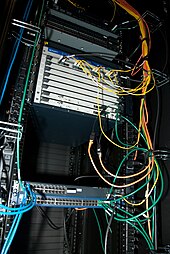
Communications in data centers today are most often based onnetworksrunning theInternet protocol suite.Data centers contain a set ofroutersandswitchesthat transport traffic between the servers and to the outside world[136]which are connected according to thedata center network architecture.Redundancyof the internet connection is often provided by using two or more upstream service providers (seeMultihoming).
Some of the servers at the data center are used for running the basic internet andintranetservices needed by internal users in the organization, e.g., e-mail servers,proxy servers,andDNSservers.
Network security elements are also usually deployed:firewalls,VPNgateways,intrusion detection systems,and so on. Also common are monitoring systems for the network and some of the applications. Additional off-site monitoring systems are also typical, in case of a failure of communications inside the data center.
Software/data backup
[edit]Non-mutually exclusive options fordata backupare:
- Onsite
- Offsite
Onsite is traditional,[137]and one of its major advantages is immediate availability.
Offsite backup storage
[edit]Data backup techniques include having anencryptedcopy of the data offsite. Methods used for transporting data are:[138]
- Having the customer write the data to a physical medium, such as magnetic tape, and then transporting the tape elsewhere.[139]
- Directly transferring the data to another site during the backup, using appropriate links.
- Uploading the data "into the cloud".[140]
Modular data center
[edit]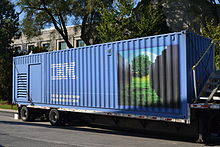
For quick deployment ordisaster recovery,several large hardwarevendorshave developed mobile/modular solutions that can be installed and made operational in a very short amount of time.
Micro data center
[edit]Micro data centers (MDCs)are access-level data centers which are smaller in size than traditional data centers but provide the same features.[141]They are typically located near the data source to reduce communication delays, as their small size allows several MDCs to be spread out over a wide area.[142][143]MDCs are well suited to user-facing, front end applications.[144]They are commonly used inedge computingand other areas where low latency data processing is needed.[145]
See also
[edit]- Colocation centre
- Computer cooling
- Data center management
- Disaster recovery
- Dynamic infrastructure
- Electrical network
- Internet exchange point
- Internet hosting service
- Microsoft underwater data center
- Neher–McGrath method
- Network operations center
- Open Compute Project,byFacebook
- Peering
- Server farm
- Server room
- Server Room Environment Monitoring System
- Telecommunications network
- Utah Data Center
- Web hosting service
Notes
[edit]- ^Seespelling differences.
- ^Old large computer rooms that housed machines like the U.S. Army's ENIAC, which were developed pre-1960 (1945), are now referred to asdata centers.
- ^Until the early 1960s, it was primarily the government that used computers, which were large mainframes housed in rooms that today we call data centers.
- ^In the 1990s, network-connectedminicomputers(servers) running without input or display devices were housed in the old computer rooms. These new "data centers" or "server rooms" were built within company walls, co-located with low-cost networking equipment.
- ^There was considerable construction of data centers during the early 2000s, in theperiod of expanding dot-com businesses.
- ^In May 2011, data center research organization Uptime Institute reported that 36 percent of the large companies it surveyed expect to exhaust IT capacity within the next 18 months.James Niccolai."Data Centers Turn to Outsourcing to Meet Capacity Needs".CIO magazine.Archived fromthe originalon 2011-11-15.Retrieved2011-09-09.
- ^instead of chillers/air conditioners, resulting in energy savings
References
[edit]- ^"An Oregon Mill Town Learns to Love Facebook and Apple".The New York Times.March 6, 2018.
- ^"Google announces London cloud computing data centre".BBC.com.July 13, 2017.
- ^"Cloud Computing Brings Sprawling Centers, but Few Jobs".The New York Times.August 27, 2016.
data center.. a giant.. facility.. 15 of these buildings, and six more.. under construction
- ^"From Manhattan to Montvale".The New York Times.April 20, 1986.
- ^Ashlee Vance(December 8, 2008)."Dell Sees Double With Data Center in a Container".The New York Times.
- ^James Glanz (September 22, 2012)."Power, Pollution and the Internet".The New York Times.Retrieved2012-09-25.
- ^"Data centres & networks".IEA.Retrieved2023-10-07.
- ^abcCalma, Justine (2024-01-24)."AI and crypto mining are driving up data centers' energy use".The Verge.Retrieved2024-08-21.
- ^"Types of Data Centers | How do you Choose the Right Data Center?".Maysteel Industries, LLC.Retrieved2023-10-07.
- ^abcAngela Bartels (August 31, 2011)."Data Center Evolution: 1960 to 2000".Archived fromthe originalon October 24, 2018.RetrievedOctober 24,2018.
- ^abcCynthia Harvey (July 10, 2017)."Data Center".Datamation.
- ^abJohn Holusha (May 14, 2000)."Commercial Property/Engine Room for the Internet; Combining a Data Center With a 'Telco Hotel'".The New York Times.RetrievedJune 23,2019.
- ^H Yuan."Workload-Aware Request Routing in Cloud Data Center".Journal of Systems Engineering and Electronics.doi:10.1109/JSEE.2015.00020.S2CID59487957.
- ^Quentin Hardy (October 4, 2011)."A Data Center Power Solution".The New York Times.
- ^"Gartner Says Worldwide Data Center Infrastructure Spending to Grow 6% in 2021".Gartner, Inc.Retrieved6 July2024.
- ^Petroc, Taylor."Volume of data/information created, captured, copied, and consumed worldwide from 2010 to 2020, with forecasts from 2021 to 2025 (in zettabytes)".Statista.Retrieved6 July2024.
- ^Petroc, Taylor."Leading countries by number of data centers as of March 2024".Statista.
- ^"Investing in the rising data center economy".McKinsey & Co.Retrieved6 July2024.
- ^"Investing in the rising data center economy".McKinsey & Co.Retrieved6 July2024.
- ^"Powering Intelligence: Analyzing Artificial Intelligence and Data Center Energy Consumption".Electric Power Research Institute (EPRI).Retrieved6 July2024.
- ^"Powering Intelligence: Analyzing Artificial Intelligence and Data Center Energy Consumption".Electric Power Research Institute (EPRI).Retrieved6 July2024.
- ^ab"Mukhar, Nicholas." HP Updates Data Center Transformation Solutions, "August 17, 2011".Archived fromthe originalon August 12, 2012.RetrievedSeptember 9,2011.
- ^"Sperling, Ed." Next-Generation Data Centers, "Forbes, March 15. 2010".Forbes.com.Retrieved2013-08-30.
- ^"IDC white paper, sponsored by Seagate"(PDF).
- ^"Data centers are aging, unsuited for new technologies".December 10, 2007.
- ^"Data center staff are aging faster than the equipment".Network World.August 30, 2018.Archivedfrom the original on December 7, 2023.RetrievedDecember 21,2018.
- ^"TIA-942 Certified Data Centers - Consultants - Auditors - TIA-942.org".www.tia-942.org.
- ^"Telecommunications Standards Development".Archived fromthe originalon November 6, 2011.RetrievedNovember 7,2011.
- ^"GR-3160 - Telecommunications Data Center - Telcordia".telecom-info.njdepot.ericsson.net.
- ^"Tang, Helen." Three Signs it's time to transform your data center, "August 3, 2010, Data Center Knowledge".Archived fromthe originalon August 10, 2011.RetrievedSeptember 9,2011.
- ^"the Era of Great Data Center Consolidation".Fortune.February 16, 2017.
'Friends don't let friends build data centers,' said Charles Phillips, chief executive officer of Infor, a business software maker
- ^"This Wave of Data Center Consolidation is Different from the First One".February 8, 2018.
- ^"Start A Fire".startafire.com.
- ^"Stop Virtual Server Sprawl".IBMsystemsMagazine.com.Archived fromthe originalon 2018-10-23.Retrieved2018-11-01.
- ^"Top reasons to upgrade vintage data centers"(PDF).
- ^ab"Complexity: Growing Data Center Challenge".Data Center Knowledge.May 16, 2007.
- ^"Carousel's Expert Walks Through Major Benefits of Virtualization".technews.tmcnet.com.
- ^Stephen Delahunty (August 15, 2011)."The New urgency for Server Virtualization".InformationWeek.Archived fromthe originalon 2012-04-02.
- ^"HVD: the cloud's silver lining"(PDF).Intrinsic Technology. Archived fromthe original(PDF)on October 2, 2012.RetrievedAugust 30,2012.
- ^"Gartner: Virtualization Disrupts Server Vendors".December 2, 2008.
- ^"Ritter, Ted. Nemertes Research," Securing the Data-Center Transformation Aligning Security and Data-Center Dynamics "".Archived fromthe originalon 2017-06-25.Retrieved2011-09-09.
- ^"GR-2930 - NEBS: Raised Floor Requirements".
- ^ab"Data Center Raised Floor History"(PDF).
- ^"Raised Floor Info | Tips for Ordering Replacement Raised Floor Tiles".www.accessfloorsystems.com.
- ^Hwaiyu Geng (2014).Data Center Handbook.John Wiley & Sons.ISBN978-1118436639.
- ^Steven Spinazzola (2005)."HVAC: The Challenge And Benefits of Under Floor Air Distribution Systems".FacilitiesNet.com.
- ^"Premier 100 Q&A: HP's CIO sees 'lights-out' data centers".Informationweek.March 6, 2006. Archived fromthe originalon July 12, 2019.
- ^Victor Kasacavage (2002).Complete book of remote access: connectivity and security.The Auerbach Best Practices Series. CRC Press. p. 227.ISBN0-8493-1253-1.
- ^Roxanne E. Burkey; Charles V. Breakfield (2000).Designing a total data solution: technology, implementation and deployment.Auerbach Best Practices. CRC Press. p. 24.ISBN0-8493-0893-3.
- ^Clarke, Renaud (2020-07-01)."Acoustic Barriers for Data Centres".IAC Acoustics.Retrieved2023-02-11.
- ^Thibodeau, Patrick (2007-07-31)."That sound you hear? The next data center problem".Computerworld.Retrieved2023-02-11.
- ^Sensear."Data Center Noise Levels".Sensear.Retrieved2023-02-11.
- ^Weisbrod, Katelyn (2023-02-10)."In Northern Virginia, a Coming Data Center Boom Sounds a Community Alarm".Inside Climate News.Retrieved2023-02-11.
- ^Judge, Peter (2022-07-19)."Prince William residents complain of" catastrophic noise "from data centers".DCD.Retrieved2023-02-11.
- ^Judge, Peter (2022-07-27)."Chicago residents complain of noise from Digital Realty data center".DCD.Retrieved2023-02-11.
- ^Phillips, Mark (2021-11-30)."Chandler to consider banning data centers amid noise complaints".ABC15 Arizona in Phoenix (KNXV).Retrieved2023-02-11.
- ^"Data Center Soundproofing and Noise Control- Reduce Server Noise".DDS Acoustical Specialties.Retrieved2023-02-11.
- ^Bosker, Bianca (2019-12-06)."Your" cloud "data is making noise on the ground".Marketplace.Retrieved2023-02-11.
- ^Patrick Thibodeau (April 12, 2016)."Envisioning a 65-story data center".Computerworld.
- ^"Google container data center tour (video)".YouTube.7 April 2009.Archivedfrom the original on 2021-11-04.
- ^"Romonet Offers Predictive Modeling Tool For Data Center Planning".June 29, 2011. Archived fromthe originalon August 23, 2011.RetrievedFebruary 8,2012.
- ^ab"BICSI News Magazine - May/June 2010".www.nxtbook.com.
- ^"Hedging Your Data Center Power".
- ^Clark, Jeffrey. "The Price of Data Center Availability—How much availability do you need?", Oct. 12, 2011, The Data Center Journal"Data Center Outsourcing in India projected to grow according to Gartner".Archived fromthe originalon 2011-12-03.Retrieved2012-02-08.
- ^"Five tips on selecting a data center location".
- ^"IBM zEnterprise EC12 Business Value Video".YouTube.Archived fromthe originalon 2012-08-29.
- ^Niles, Susan. "Standardization and Modularity in Data Center Physical Infrastructure," 2011, Schneider Electric, page 4."Standardization and Modularity in Data Center Physical Infrastructure"(PDF).Archived fromthe original(PDF)on 2012-04-16.Retrieved2012-02-08.
- ^"Strategies for the Containerized Data Center".September 8, 2011.
- ^Niccolai, James (2010-07-27)."HP says prefab data center cuts costs in half".
- ^"tw telecom and NYSERDA Announce Co-location Expansion".Reuters.2009-09-14. Archived fromthe originalon 2009-09-26.
- ^"Air to air combat - indirect air cooling wars".
- ^Detailed explanation of UPS topologies"EVALUATING THE ECONOMIC IMPACT OF UPS TECHNOLOGY"(PDF).Archived fromthe original(PDF)on 2010-11-22.
- ^"Cable tray systems support cables' journey through the data center".April 2016.
- ^Mike Fox (2012-02-15)."Stulz announced it has begun manufacturing In Row server cooling units under the name" CyberRow "".DataCenterFix.Archived fromthe originalon March 1, 2012.RetrievedFebruary 27,2012.
- ^Hot-Aisle vs. Cold-Aisle Containment for Data Centers,John Niemann, Kevin Brown, and Victor Avelar, APC by Schneider Electric White Paper 135, Revision 1
- ^"US Patent Application for DUCTED EXHAUST EQUIPMENT ENCLOSURE Patent Application (Application #20180042143 issued February 8, 2018) - Justia Patents Search".patents.justia.com.Retrieved2018-04-17.
- ^"Airflow Management Basics – Comparing Containment Systems • Data Center Frontier".Data Center Frontier.2017-07-27. Archived fromthe originalon 2019-02-19.Retrieved2018-04-17.
- ^"Data Center Fire Suppression Systems: What Facility Managers Should Consider".Facilitiesnet.
- ^Sarah D. Scalet (2005-11-01)."19 Ways to Build Physical Security Into a Data Center".Csoonline.com. Archived fromthe originalon 2008-04-21.Retrieved2013-08-30.
- ^Systems and methods for controlling an electronic lock for a remote device,2016-08-01,retrieved2018-04-25
- ^"Data Center Energy Consumption Trends".U.S. Department of Energy.Retrieved2010-06-10.
- ^J. Koomey, C. Belady, M. Patterson, A. Santos, K.D. Lange: Assessing Trends Over Time in Performance, Costs, and Energy Use for ServersReleased on the web August 17th, 2009.
- ^abc"Data Centres and Data Transmission Networks – Analysis".IEA.Retrieved2022-03-06.
- ^Kantor, Alice (2021-05-18)."Big Tech races to clean up act as cloud energy use grows".Financial Times.Archivedfrom the original on 2022-12-10.Retrieved2022-03-06.
- ^Siddik, Md Abu Bakar; Shehabi, Arman; Marston, Landon (2021-05-21)."The environmental footprint of data centers in the United States".Environmental Research Letters.16(6): 064017.Bibcode:2021ERL....16f4017S.doi:10.1088/1748-9326/abfba1.hdl:10919/109747.ISSN1748-9326.S2CID235282419.
- ^James, Greg (2022-03-01)."Tencent pledges to achieve carbon neutrality by 2030".SupChina.Archived fromthe originalon 2022-07-11.Retrieved2022-03-06.
- ^Craig Hale (2024-07-15)."Google and Microsoft now each consume more power than some fairly big countries".TechRadar.Retrieved2024-07-18.
- ^"Report to Congress on Server and Data Center Energy Efficiency"(PDF).U.S. Environmental Protection Agency ENERGY STAR Program.
- ^"Data Center Energy Forecast"(PDF).Silicon Valley Leadership Group. Archived fromthe original(PDF)on 2011-07-07.Retrieved2010-06-10.
- ^"Efficiency: How we do it – Data centers".Retrieved2015-01-19.
- ^"Immersion cooling firm LiquidStack launches as a stand-alone company".
- ^Commentary on introduction of Energy Star for Data Centers"Introducing EPA ENERGY STAR for Data Centers".Jack Pouchet. 2010-09-27. Archived fromthe original(Web site)on 2010-09-25.Retrieved2010-09-27.
- ^"EU Code of Conduct for Data Centres".iet.jrc.ec.europa.eu. Archived fromthe originalon 2013-08-11.Retrieved2013-08-30.
- ^"UNICOM Global:: Home"(PDF).www.gtsi.com.Archived fromthe original(PDF)on 2012-12-03.Retrieved2012-02-08.
- ^Daniel Minoli (2011).Designing Green Networks and Network Operations: Saving Run-the-Engine Costs.CRC Press. p. 5.ISBN9781439816394.
- ^Rabih Bashroush (2018)."A Comprehensive Reasoning Framework for Hardware Refresh in Data Centres".IEEE Transactions on Sustainable Computing.3(4): 209–220.doi:10.1109/TSUSC.2018.2795465.S2CID54462006.
- ^abPeter Sayer (March 28, 2018)."What is the Open Compute Project?".NetworkWorld.Archivedfrom the original on November 29, 2023.RetrievedFebruary 3,2019.
- ^Peter Judge (March 9, 2016)."OCP Summit: Google joins and shares 48V tech".DCD Data center Dynamics.
- ^abJoe Cosmano (2009),Choosing a Data Center(PDF),Disaster Recovery Journal,retrieved2012-07-21[permanent dead link]
- ^David Garrett (July 9, 2004),"Heat Of The Moment",Processor,26(28), archived fromthe originalon 2013-01-31,retrieved2012-07-21
- ^Needle, David (25 July 2007)."HP's Green Data Center Portfolio Keeps Growing".InternetNews.Archivedfrom the original on Oct 25, 2020.
- ^"How to Choose a Data Center",Inc.,Nov 29, 2010, archived fromthe originalon Mar 8, 2013,retrieved2012-07-21
- ^Kathryn, Siranosian (April 5, 2011)."HP Shows Companies How to Integrate Energy Management and Carbon Reduction".TriplePundit.Archived fromthe originalon August 22, 2018.RetrievedFebruary 8,2012.
- ^Rabih Bashroush; Eoin Woods (2017). "Architectural Principles for Energy-Aware Internet-Scale Applications".IEEE Software.34(3): 14–17.doi:10.1109/MS.2017.60.S2CID8984662.
- ^Bullock, Michael. "Computation Fluid Dynamics - Hot topic at Data Center World," Transitional Data Services, March 18, 2010.ArchivedJanuary 3, 2012, at theWayback Machine
- ^"Bouley, Dennis (editor)." Impact of Virtualization on Data Center Physical Infrastructure, "The Green grid, 2010"(PDF).Archived fromthe original(PDF)on 2014-04-29.Retrieved2012-02-08.
- ^"HP Thermal Zone Mapping plots data center hot spots".Archived fromthe originalon 2021-01-26.Retrieved2012-02-08.
- ^"Fjord-cooled DC in Norway claims to be greenest".23 December 2011.Retrieved23 December2011.
- ^Canada Called Prime Real Estate for Massive Data Computers - Globe & MailRetrieved June 29, 2011.
- ^Finland - First Choice for Siting Your Cloud Computing Data Center..Retrieved 4 August 2010.
- ^"Stockholm sets sights on data center customers".Archived fromthe originalon 19 August 2010.Retrieved4 August2010.
- ^In a world of rapidly increasing carbon emissions from the ICT industry, Norway offers a sustainable solutionArchived2020-10-29 at theWayback MachineRetrieved 1 March 2016.
- ^Swiss Carbon-Neutral Servers Hit the Cloud..Retrieved 4 August 2010.
- ^Baxtel."Singapore Data Centers & Colocation".baxtel.com.Retrieved2024-09-18.
- ^"Singapore authorities invite applications for new data centers".
- ^"BCA-IMDA Green Mark for Data Centres Scheme".Infocomm Media Development Authority.Retrieved2024-09-18.
- ^"Singapore to free up 300MW for data centres".Capacity Media.2024-05-30.Retrieved2024-09-18.
- ^"4 Proposals Selected from Data Centre Application".Infocomm Media Development Authority.Retrieved2024-09-18.
- ^Could DC win the new data center War of the Currents?
- ^"Direct Current (DC) Power | Center of Expertise for Energy Efficiency in Data Centers".
- ^"Data Center Cooling with Heat Recovery"(PDF).StockholmDataParks.com.January 23, 2017.
- ^Halper, Evan (2024-03-07)."Amid explosive demand, America is running out of power".Washington Post.Retrieved2024-08-19.
- ^Rogers, Reece (July 11, 2024)."AI's Energy Demands Are Out of Control. Welcome to the Internet's Hyper-Consumption Era".Wired.ISSN1059-1028.Retrieved2024-08-19.
- ^abChow, Andrew R. (2024-06-12)."How AI Is Fueling a Boom in Data Centers and Energy Demand".TIME.Retrieved2024-08-21.
- ^Petersen, Melody (2024-08-12)."Power-hungry AI data centers are raising electric bills and blackout risk".Los Angeles Times.Retrieved2024-08-19.
- ^Benetton, Matteo; Compiani, Giovanni; Morse, Adair (2023-08-12)."When cryptomining comes to town: High electricity use spillovers to the local economy".VoxEU.Retrieved2024-08-20.
- ^Vincent, James (2022-07-28)."The electricity demands of data centers are making it harder to build new homes in London".The Verge.Retrieved2024-08-21.
- ^Walton, Robert (July 8, 2024)."US electricity prices rise again as AI, onshoring may mean decades of power demand growth: BofA".Utility Dive.Retrieved2024-08-19.
- ^Mott, Filip De."Utility bills are getting cheaper, but AI could spoil the party".Markets Insider.Retrieved2024-08-19.
- ^"A.I. Power Shortage. Plus, Oil & Gas Stock Picks - Barron's Streetwise Barron's Podcasts".Barron's.May 17, 2024.Retrieved2024-08-21.
- ^"Method for Dynamic Information Technology Infrastructure Provisioning".
- ^Meyler, Kerrie (April 29, 2008)."The Dynamic Datacenter".Network World.
- ^"Computation on Demand: The Promise of Dynamic Provisioning".[permanent dead link]
- ^"Just What the Heck Is Composable Infrastructure, Anyway?".IT Pro.July 14, 2016.
- ^Montazerolghaem, Ahmadreza (2020-07-13)."Software-defined load-balanced data center: design, implementation and performance analysis"(PDF).Cluster Computing.24(2): 591–610.doi:10.1007/s10586-020-03134-x.ISSN1386-7857.S2CID220490312.
- ^Mohammad Noormohammadpour; Cauligi Raghavendra (July 16, 2018). "Datacenter Traffic Control: Understanding Techniques and Tradeoffs".IEEE Communications Surveys & Tutorials.20(2): 1492–1525.arXiv:1712.03530.doi:10.1109/comst.2017.2782753.S2CID28143006.
- ^"Protecting Data Without Blowing The Budget, Part 1: Onsite Backup".Forbes.October 4, 2018.
- ^"Iron Mountain vs Amazon Glacier: Total Cost Analysis"(PDF).Archived fromthe original(PDF)on 2018-10-28.Retrieved2018-10-28.
- ^What IBM calls "PTAM: Pickup Truck Access Method.""PTAM - Pickup Truck Access Method (disaster recovery slang)".
- ^"Iron Mountain introduces cloud backup and management service".Network world.September 14, 2017. Archived fromthe originalon February 18, 2024.RetrievedOctober 28,2018.
- ^Ibrahim, Rosdiazli; Porkumaran, K.; Kannan, Ramani; Nor, Nursyarizal Mohd; Prabakar, S. (2022-11-13).International Conference on Artificial Intelligence for Smart Community: AISC 2020, 17–18 December, Universiti Teknologi Petronas, Malaysia.Springer Nature. p. 461.ISBN978-981-16-2183-3.
- ^Guo, Song; Qu, Zhihao (2022-02-10).Edge Learning for Distributed Big Data Analytics: Theory, Algorithms, and System Design.Cambridge University Press. pp. 12–13.ISBN978-1-108-83237-3.
- ^Resources, Management Association, Information (2022-04-01).Research Anthology on Edge Computing Protocols, Applications, and Integration.IGI Global. p. 55.ISBN978-1-6684-5701-6.
{{cite book}}:CS1 maint: multiple names: authors list (link) - ^Furht, Borko; Escalante, Armando (2011-12-09).Handbook of Data Intensive Computing.Springer Science & Business Media. p. 17.ISBN978-1-4614-1414-8.
- ^Srivastava, Gautam; Ghosh, Uttam; Lin, Jerry Chun-Wei (2023-06-24).Security and Risk Analysis for Intelligent Edge Computing.Springer Nature. p. 17.ISBN978-3-031-28150-1.
External links
[edit]- Lawrence Berkeley Lab- Research, development, demonstration, and deployment of energy-efficient technologies and practices for data centers
- DC Power For Data Centers Of The Future- FAQ: 380VDC testing and demonstration at a Sun data center.
- White Paper- Property Taxes: The New Challenge for Data Centers
- The European Commission H2020 EURECA Data Centre Project- Data centre energy efficiency guidelines, extensive online training material, case studies/lectures (under events page), and tools.

